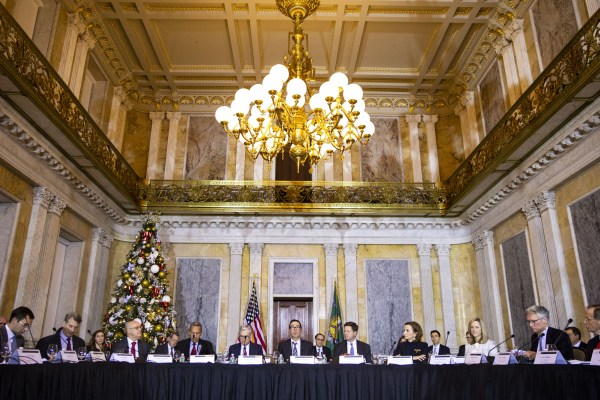It’s time to put on our thinking caps so we can discuss an esoteric but important policy change and how it is going to impact the VC world.
The 2008 financial crisis devastated the global economy. One of the reforms that came from the detritus of that situation was a policy known as the Volcker Rule.
The rule, proposed by former Fed chairman Paul Volcker and passed into law with the Dodd-Frank Act, was designed to limit the ways that banks could invest their balance sheets to avoid the kind of cataclysmic systemic risks that the world witnessed during the crisis. Many banks faced a liquidity crunch after investing in mortgage-backed securities (MBSs), collateralized debt obligations (CDOs), and other even more arcane speculative financial instruments (like POGs, or Piles Of Garbage) in seeking profits.
A number of reforms are underway to the Volcker Rule, which has been a domestic regulatory priority for the Trump administration since Inauguration Day.
One of the unintended consequences of the rule is that it limited banks from investing in certain “covered funds,” which was written broadly enough that it, well, covered VC firms as well as hedge funds and other private equity vehicles. Reforms to that policy (and to the rule in general) have been proposed for a decade with little traction until recently.
Now, a number of reforms are underway to the Volcker Rule, which has been a domestic regulatory priority for the Trump administration since Inauguration Day.
First, a simplification to some of the rule’s regulations was passed late last year and went into effect in January. Now, a final rule to reform the Volcker Rule’s applications to VC firms, among other issues, was agreed to by a group of U.S. regulatory agencies, and will go into effect later this year.
According to the summary provided by the Federal Reserve, the new rule will allow banks to invest in venture capital firms with some restrictions, including that the bank cannot guarantee a fund’s performance to potential investors and the VC firm cannot engage in any proprietary trading.
In its analysis, the Federal Reserve’s statement said, “The limitations on qualifying venture capital funds would help to address the policy goals of Congress when enacting the Volcker Rule, including eliminating incentives that a banking entity may have to bail out a covered fund during times of stress.”
That’s the news, so what does that mean for the venture capital industry?
First and very obviously, banks could potentially take a greater role as LPs and as sponsors of VC funds. Banks already have an intimate relationship with VC firms through their transactional work, but now they could take a much greater role in asset allocation and capital formation, up to and potentially including anchoring funds as a major LP. Banks have some of the largest balance sheets in the world, and even a small change in their asset allocation strategies could see money flowing into the VC world.
But the more nuanced change is that the reform could help smaller funds in cities outside major hubs like San Francisco and New York raise capital.
Such investments have been rare. Among the most notable examples in recent years came from Goldman Sachs, which invested $200 million into VC firm General Catalyst in 2018 and made an investment in major secondary buyer Industry Ventures in 2019, according to The Wall Street Journal’s Yuliya Chernova. Those investments were through its Petershill unit.
As some of the largest VC firms grow their assets under management, they increasingly need to find larger LPs to continue to fuel and sustain their growth. With more concerns arising about taking funding from large international sovereign wealth funds in the Middle East and Asia, opening up a pathway to American banking institutions could substitute for some of that cross-border capital.
But the more nuanced change is that the reform could help smaller funds in cities outside major hubs like San Francisco and New York raise capital.
Justin Field, the senior vice president for government relations at the VC industry’s trade group the National Venture Capital Association, explained that the rule doesn’t just help the big national banks, but also smaller regional banks. “We think that, in particular, this is going to have an outsized impact on regional emerging ecosystems, where you have smaller venture capital funds and capital is generally harder to come by,” he said. For funds outside major ecosystems, “those are folks that can’t go to your large institutional investors because they’re just too small for folks to write that check and do due diligence.”
The hope is that by easing the Volcker Rule, regional banks could potentially catalyze new VC funds in their own backyards, expanding access to venture capital.
It’s mostly good news for startups and VC firms, particularly given the economic environment in the wake of the pandemic. VC fundraising has taken a hit as pension funds and other LPs struggle to overcome the denominator effect and rebalance their portfolios. While those fundraising challenges are widely not expected to last, even a delay of a couple of months can wildly change the economics for new fund managers.
All that said, even minor changes to the Volcker Rule have been criticized in the past, with analysts arguing that weakening the rule’s provisions will make a financial crisis more likely. Ultimately, the Federal Reserve and regulatory agencies like the FDIC tried to find a middle road compromise that increases access to needed VC funds while also protecting the long-term resiliency of the American economy.
